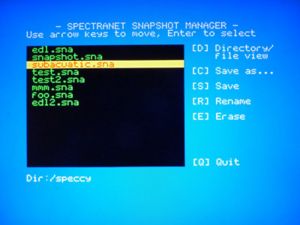Current events
Portable network fileserver
The current job is a portable fileserver program for the simple TNFS protocol.
The server program I have used to test the filesystem is something I hacked together using perl, for reasons of expediency. However, to make it simple for Windows users (and don't have a perl interpreter by default), and also as a basis for a fileserver for 8 bit systems, I'm writing a lightweight server in C. It'll also be better for "retroservers" like the MicroVAX that I have. Although the perl server runs on the VAX with adequate speed, a server written in C will run a lot faster. The idea is to have something very portable and small and simple. The architectures I intend to test with the first version will be sparc64 (big endian, 64 bit), VAX (little endian, 32 bit), Win32 (x86, little endian, 32 bit), macppc (32 bit big endian) and mac on intel (x86_64, 64 bit little endian). The endianness matters for testing because 16 and 32 bit integers are encoded as 16 and 32 bit values in the datagrams as little endian values (most 8 bit systems seem to deal with 16 or 32 bit values in a little endian manner).
My goal at the moment is to make the "simple" TNFS server. This TNFS server is for LAN use, so that someone may share files between their PC and a Spectrum. It doesn't include things like authentication and authorization. The idea is that the user sets the server up to share a specific directory tree and it works a bit like ResiDOS - it lets you access files within. A later goal is to find out what I need to use for ESXDOS on the Spectrum, and make a Speccy version of the fileserver, so it can serve files from a DivIDE. All the protocol level stuff should be portable, as will the network code. Filesystem level stuff will probably need some Speccy-specific #asm sections - given that ESXDOS is brand new it may be some time before the z88dk gets ESXDOS support for its base I/O libraries. (However, ESXDOS does have a POSIX like interface which should mean it won't be too bad to port).
Later, I may make a proper "multiuser server" (that is, it'll integrate with the host OS authentication and authorization methods). However, I'll only do this for Unix. The last time I touched Windows at this level was with NT 4.0 and lots of things have changed with Vista and newer, so someone more familiar than me with the Windows security model would have to take that up.
The snapshot manager
Unfortunately "real life" problems have kept me away from doing serious work with the Spectranet software for a week or three, so I'm well behind where I expected to be. However, I still managed to get the first pass of the snapshot manager working. At the moment it's rather rudimentary, but it does at least have a scrollable file/directory browser, and it can load and save snapshots. It is invoked via the NMI menu (and is a ROM module). I am also moving the snapshot code itself to this module - for testing, this had lived in the BASIC extensions module. Hopefully, by next week I'll have the current firmware in a state where it's worthy of making a video update on what the Spectranet does so far.
The other feature I need to add is a rename system call for filesystems in the base ROM. This will need a slight rearrangement of some internal functions because the jump table is full, and there are some functions that can be combined or moved elsewhere to free up entries (I don't really want the jump table to take up more than 256 bytes). Also I need to write a portable TNFS server (the current one is in Perl, and although this is portable enough, Windows users generally don't have a perl interpreter, and most importantly - a Spectrum will never have a perl interpreter and I want the Spectrum itself to be able to be a file server for the ultimate retro network). Then after that, get some new hardware made for those who want one!
Winston 23:05, 28 December 2009 (GMT)
